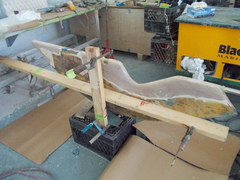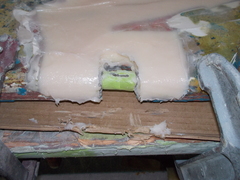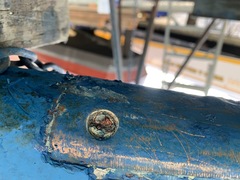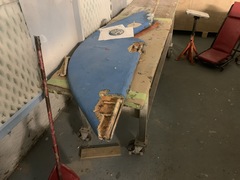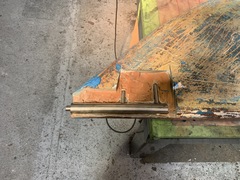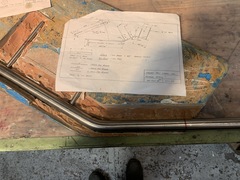The problem
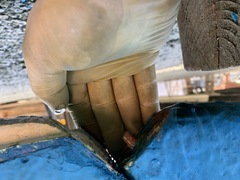 Last fall, the surveyor found that there was a lot of slop in my
rudder. This spring, when I hauled it out expecting to just have
to replace the bottom pin, 5 days max, done. It turned into a 2
month saga.
First off, yup there was a lot of slop in the rudder. Removing
the shoe confirmed that the bottom pin was mostly gone:
Last fall, the surveyor found that there was a lot of slop in my
rudder. This spring, when I hauled it out expecting to just have
to replace the bottom pin, 5 days max, done. It turned into a 2
month saga.
First off, yup there was a lot of slop in the rudder. Removing
the shoe confirmed that the bottom pin was mostly gone:
If there was a bit more pin, the solution is just to make a bushing to fit between the hole in the rudder shoe and the pin. But this pin was too far gone for that. The second solution is to cut out the pin, drill and tap a hole in the bottom section and screw in a new pin. I might have done that if there hadn't been other problems.

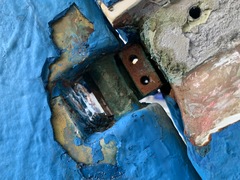 There was also slop in the middle bearing. Removing the
gudgeons revealed that it also was missing quite a bit
of metal, and what was showing was de-zincified.
There was also slop in the middle bearing. Removing the
gudgeons revealed that it also was missing quite a bit
of metal, and what was showing was de-zincified.
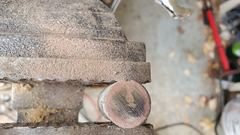 There was a bit of discussion on the Facebook page, with the
(erroneous) concensus being that I should just make a bushing
for it, forget about it and go sailing. I'm very glad I ignored
that advice. This is what the inside of the pin ended up
looking like:
There was a bit of discussion on the Facebook page, with the
(erroneous) concensus being that I should just make a bushing
for it, forget about it and go sailing. I'm very glad I ignored
that advice. This is what the inside of the pin ended up
looking like:
There was maybe a quarter inch of good metal left, and even that was compromised with a bit of de-zincification running right into the centre.
 There was also dezincification on the upper part of the shaft:
There was also dezincification on the upper part of the shaft:
My boat is a 1972 boat, #495. Some of the following my not be relevant to your boat. The rudder shaft was in 3 parts.
- One longer section going from the tiller head, through the lower bearing in the hull and into the rudder with a bend around the propellor aperture. 1-inch thick. This piece has two keyways cut into it, one at the top for a tiller, one lower down for wheel steering.
- One very short section at the midpoint 3/4 inch thick
- The bottom section with a pin to fit into the rudder shoe.
 Basically the parts were as shown
in this
page. This picture, from a later stage in the operation,
shows how they fit into the rudder.
Basically the parts were as shown
in this
page. This picture, from a later stage in the operation,
shows how they fit into the rudder.
The thin spurs coming out of the top section are largely ornamental. They're quite thin. The torque from the tiller is transmitted to the rudder because the 1-inch upper shaft has bends in it, not because of the spurs, which can be bent by hand. One the two smaller bits, the spurs stop the part from spinning with the rudder. One the midpoint section the brazing had failed. On my boat, the 3 parts were not correctly aligned. The midpoint section was 1/8 inch out of column with the top and bottom sections, probably because it's thinner (3/4 inch) and whoever put the rudder together back in 1972 lined up the sides of the parts, not the centres.
All in all, it was pretty obvious that the rudder needed to be removed and all the metal replaced.
Removing the rudder
At least one Alberg has a bolt on rudder. I don't. Removing the rudder was a lot of work.
First off, the propellor shaft blocks the rudder from dropping down. That meant either pulling out the propellor shaft altogether or moving the engine forward 2 inches and pushing the propellor shaft forward 2 inches so the rudder can clear the end. The first option mean removing the coupling from the engine and also removing it from the shaft. I was advised that removing the coupling from the shaft would be a lot of work in a very confined space, so I went with moving the engine forward. It was also a lot of work. I'm still not sure that was the way to go. Actually, I am sure, because it revealed that two of the bolts holding down the engine were rusted out, which I wouldn't have found out otherwise. But if there hadn't been any other problems, I think it's about 50-50 which way to go. Because the engine only had to be moved a few inches, it was really only a question of removing a few bolts. Most of the hoses and wires could stay in place.
Next problem is that access to the rudderpost stuffing box was needed. On my boat, this is behind and under the gas tank. I've removed the gas tank on two previous occaisons, so this step was fairly straightforward, if annoying. I removed the wooden bulkhead between the engine compartment and the starboard cockpit locker. The first time I did this, it took a while because I was nervous about wrecking the bonds between the fibreglass and the wood. But when I put it back, I just screwed everything back together so it's relatively easy to remove, as long as you don't mind spending an hour kneeling in the cockpit, with your head below knee level in the cockpit.
There are people who will tell you that the way to remove a rudder is to dig a hole under the stern of the boat while it's on the hard. I'm not sure how that would work. The rudder post is at an angle, so you would have to dig the hole under the aftermost part of the keel, leaving it unsupported. Anyway, the yard frowns on hole-digging and lifted the boat to drop the rudder. At this point, it was discovered that the packing in the rudder stuffing box hadn't been put in correctly and was leaking slightly.
Rebuild

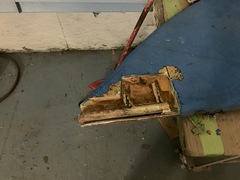 For each section of the rudder post, a series of
exploratory holes was drilled to figure out exactly where the
pieces actually were. Then the top side of the rudder was ground
off to expose each piece. The rudder is built like a surfboard,
with a GRP skin, and a foam core. Once the locations were
determined, the pieces were cut out using nice, straight cuts.
For each section of the rudder post, a series of
exploratory holes was drilled to figure out exactly where the
pieces actually were. Then the top side of the rudder was ground
off to expose each piece. The rudder is built like a surfboard,
with a GRP skin, and a foam core. Once the locations were
determined, the pieces were cut out using nice, straight cuts.

 New pieces were fabricated, identical to the originals, but
stainless steel, not navy brass. I would have prefered bronze,
but there was none in stock and it would taken multiple weeks
and a border crossing to arrive. The new stainless is much
stronger than the original brass. I worry vaguely about
crevice corrosion, but almost all rudder shafts are stainless
these days with very few problems. I can't say that the
brass was problem free.
New pieces were fabricated, identical to the originals, but
stainless steel, not navy brass. I would have prefered bronze,
but there was none in stock and it would taken multiple weeks
and a border crossing to arrive. The new stainless is much
stronger than the original brass. I worry vaguely about
crevice corrosion, but almost all rudder shafts are stainless
these days with very few problems. I can't say that the
brass was problem free.

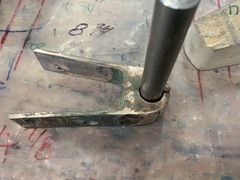 The midpoint gudgeons and the shoe were also slightly
worn. They had metal added to them by welding and then
machined back to the correct dimensions.
The midpoint gudgeons and the shoe were also slightly
worn. They had metal added to them by welding and then
machined back to the correct dimensions.
 All the bits were clamped in place. Then the rudder
was temporarily reinstalled to check alignment.
All the bits were clamped in place. Then the rudder
was temporarily reinstalled to check alignment.
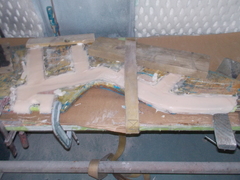
 The new pieces were epoxied in and the gaps covered
by thickened epoxy:
The new pieces were epoxied in and the gaps covered
by thickened epoxy:
I left all this stage to the professionals. I simply did not have time and space to do this. I also don't have the tools to bend 1-inch stainless rod, or weld. But as you can imagine, it wasn't cheap. The result is, however, better than new. Stronger, and built to a higher precision than Whitby Boatworks did when they built the boat in the first place.
The reinstallion was pretty straightforward, with another lift of the boat, and inserting the rudder. Note that the screws that hold the rudder shoe actually penetrate the hull, at least on my boat. The yard guys says he sees this a lot on full keel boats. When they're being built, getting all the glass and resin in to the very bottom behind the deadwood sometimes doesn't happen as well as it should. The upshot is that those bolts need to be properly sealed.
Then a few hours of work getting the gas tank back in and the bulkhead re-installed.
More Photos


